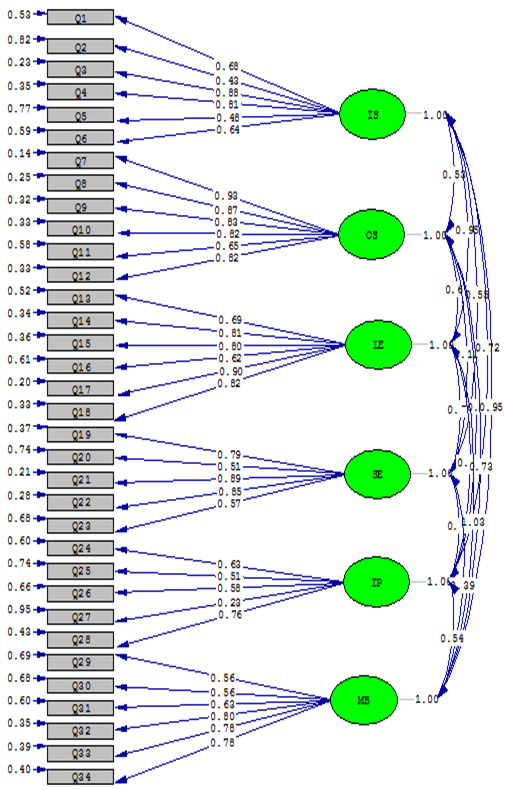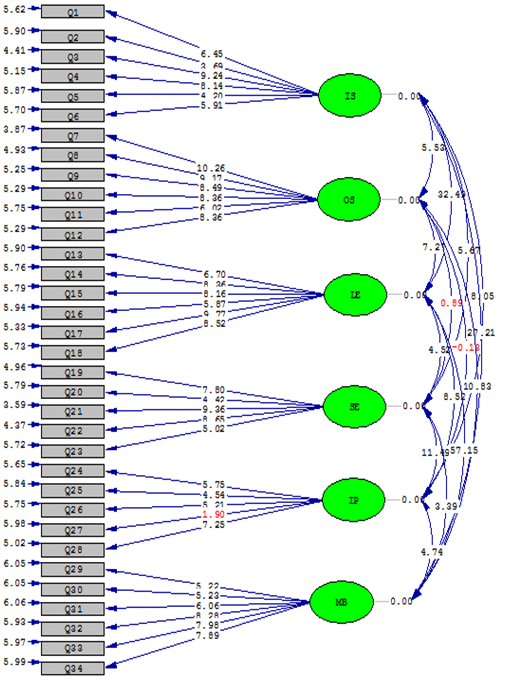Abstract
The purpose of the study was to develop a motivational Self-System instrument for learning Persian language as a second language (L2) with an acceptable validity and reliability. To do so, first of all, based on existing literature especially Zoltán Dörnyei's works and also qualitative methods, a six-factor Persian questionnaire was prepared which comprised: L2 Ideal self, L2 Ought-to self, L2 Learning experience ,L2 self-efficacy, International posture & L2 learning experience items. The population of the study consisted of foreign students of Imam Khomeini International University, Persian learning faculty of the 2015-16, second semester (N=100). The sampling method was done through a census survey and sample size was (n=73).The reliability of the questionnaire items were measured in terms of Cronbach’s alpha & bisection method. A descriptive research design, was used with Confirmatory factor analysis (CFA) for construct validity, as well as experts' input for face validity and content validity ratio (CVR) for content validity. The results from the 73 participants demonstrated that all items had an acceptable factor loading except in International posture in item no.27 which was removed from the questionnaire. The Cronbach’s alpha for the questionnaire was 0.947. The estimated significance levels were more than 0.05 for each item which demonstrated the normality of all the study variables. It can be concluded that the Persian researcher-developed questionnaire on motivational self-system has both acceptable variability and reliability.
Keywords: Motivational Self SystemSecond language(L2)Learning Persian
Introduction
Motivation plays a key role in human behaviors, and is defined as our reason and motivations to do or even not to do something. Motivation has been always been a very interesting and applicable topic of research in learning. Keller (2010) refers to motivation as one’s desires, choices and actions.
In a similar way, motivation has been considered a critical factor in human behaviour and actions such as in L2 learning; As Dörnyei (2005) notes, motivation as an important factor in learning generally and mastering a second language. Despite its importance, L2 motivational studies is still in its infancy and the complex construct of motivation needs to needs to be further investigated.
In the case of learning Persian as a L2, this necessity is more critical, as this specific area lacks investigation as evidenced by the authors who could not find any literature on Persian L2 motivational factors and models. Hence, no acceptable instrument could be found to investigate learners’ motivational variables and their relationship. As a result of this gap, Persian language instructors have no attainable instrument to analyze their instructional motivational factors and make necessary modifications to improve their insructional practices. Although there are various accessible motivational models for the teaching and learning of English Language as Foreign Language (EFL) they need a picture-like model for learners’ motivational factors which has been designed especially for their context and appropriate for Persian learning. However, Taguchi, Magid, & Papi, (2009) prepared a Persian questionnaire on learning EFL for Iranian learners, based on Dörnyei (2003 ), who examined a motivational
Considering the literature in EFL learning and other languages, the authors selected a
1.1 What is L2 Motivational Self-System
According Dörnyei (2009), the creator of the self system,
1.1.1 International Posture(IP):
Yashima (2002), describes international posture as a tendency to favor international subjects, being interested in travelling other countries, working abroad or in an international environment, openness toward foreign cultures, languages and persons and even being interested in international news and events.
1.1.2 Motivated learning behavior (MB)
This is a variable considered to operationally define the construct of motivation and has been described as the learner’s levels of practical effort to learn the L2 (Dörnyei, 2005; Dörnyei et al., 2006).
1.1.3 L2 self efficacy(SE)
Self-efficacy has been described as individuals’ beliefs in their abilities to perform a task (Bandura, 1986). Self-efficacy in learning a second/foreign language has been defined as the ways in which self-efficacy affects language learning (Raoofi, 2012)
In 2010, Papi added the l2 anxiety & intended effort (operating on a similar definition of motivated behavior) to the self-system model. Takeuchi and Ueki (2013) present a model of perceived amount of information, L2 ideal self at micro & macro levels, L2 self-efficacy, L2 learning motivated behavior and L2 anxiety. Aubrey's (2014) model also has items comprising Ideal self, Ought-to self, Motivated behavior, Learning experience and International posture.
Problem Statement
Although motivation is a key factor in L2 learning and a complex construct with multiple factors , there is to date, no appropriate questionnaire to measure learning Persian as an L2 in the related literature.
Research Question
This study investigates if the six-factor researcher-developed Motivational Self-System questionnaire has acceptable validity and reliability to measure Persian as an L2 learners' perceptions on their motivational self?
Study Purpose
The purpose of the study was to develop a Motivational Self-System instrument to investigate Persian as an L2 learning.
Research Methods
5.1.Participants
The study population consisted of foreign students of Imam Khomeini International University, in Iran(Qazvin), in the Persian language learning faculty in the 2015-16 second semester. The sample was selected based on a census survey method. The sample size at the onset of the study was N=100. However, the sample size was estimated to be sufficient at n=79 with Cochran’s formula, but for more accuracy the questionnaires were distributed to all the 100 identified sample. After acceptable questionnaires specification, the final sample size was defined at n=73. Table
5.2.Instruments
A six-factor Persian questionnaire developed by the authors based on existing literature especially Zoltán Dörnyei's works and also qualitative methods. The six-factor Persian questionnaire comprised L2 Ideal self (IS), Ought-to self (OS), Learning experience (LE), L2 self-efficacy(SE), International posture(IP) & L2 motivated behavior (MB) items. The preliminary questionnaire contained 34 items using a Likert response scale. The items of IP,SE & MB were added to the original items proposed by Dörnyei’s self-system, based on their relationship to the current study variables as presented in the literature.
5.3.Procedure
Face validity was determined through some surveys and interviews with experts on questionnaire items. The number of experts who were interviewed was 12 who according to Lawshe’s table is minimum of acceptable CVR must be 0.56. After questionnaire distribution to 100 students, 85 questionnaires were returned of which 73 acceptable questionnaires were selected. A descriptive research design using Confirmatory factor analysis (CFA) for construct validity, experts' input used for face validity and content, and validity ratio (CVR) for content validity. The reliability was measured in terms of Cronbach’s alpha & bisection method questionnaires.
5.4.Analysis
The data was analyzed using SPSS21. A confirmatory factor analysis (CFA) was used to specify the proper questions for each item of the questionnaire. The results showed that all items were acceptable except item no 27 which was discarded. Additionally, Cronbach’s alpha was applied to estimate the questionnaire reliability. Following that, the items correlation were calculated based on
Findings
The experts affirmed that all questionnaire items were valid and understandable, hence the instrument has face validity. Regarding the content validity, the CVR results are shown in table
The results of CFA and t values for each item is illustrated in table
table
The Cronbach’s alpha for the questionnaire was 0.947. The Cronbach’s alpha values for each item are demonstrated in table.
According to the Kolmogorov-Smirnov test results indicated in table
The Pearson correlation coefficient and P- values between all items are shown below in table
The values in table
The results of the Friedman test, illustrated in table
Figures


Conclusion
The present study examined the construction of a new motivational self-system instrument to investigate Persian as an L2 learning. The instrument contains six factors: L2 Ideal self (IS), Ought-to self (OS), Learning experience (LE), L2 self-efficacy (SE), International posture (IP) & L2 motivated behavior (MB) items. According the study findings, it can be concluded that the Persian researcher developed questionnaire on motivational self-system is acceptable based on its variability and also reliability and can be used in other Persian as an L2 learning contexts.
The study results concur with Papi's (2010) findings, indicating the establishment of a relationship between IS &LE, IS & OS, IS & MB, LE & OS, LE & MB, OS & MB. The relationship between IS, OS & LE with MB has been confirmed by other studies (Czier & Kormos, 2009; Taguchi et al., 2009). In addition, the strongest correlation was established between LE & MB which aligns with Papi's (2010) results which also notes LE as the strongest predictor of MB (Intended effort in his study). Furthermore, Takeuchi and Ueki (2013) claim the existence of a relationship between SE and MB and also IS as Micro & Macro Ideal selves in the case of Japanese EFL learners, which again confirms the study findings. The evidence established in this study and supported by previous research, conclusively position the new motivational self-system instrument developed by the researchers to investigate Persian as an L2 learning as a valid and reliable instrument to fill the gap in the important area of teaching and learning of Persian as an L2, providing instructors with an appropriate instrument to measure and identify potential motivational strategies to enhance this particular group of learners' language learning experiences.
Acknowledgements
The authors acknowledge dear participating students for their time, patience and finesse. We appreciate sincerely the Persian instructors & employees of Imam Khomeini International University cooperation in the procedure of collecting data.
References
- Aubrey,Scott.(2014). Development of the L2 Motivational Self System: English at a University in Japan, The research journal of the Japan Association for Language Teaching (JALT),36:1. From JALT database, on the World Wide Web: http://jalt-publications.org/files/pdf/jalt_journal/jj2014b.pdf
- Bandura, A. (1986) Social Foundations of Thought and Action: A Social Cognitive Theory Englewood Cliffs, NJ: Prentice-Hall
- Csize´r, K., Kormos, J. ( 2009). Learning experiences, selves and motivated learning behaviour: a comparative analysis of structural models for Hungarian secondary and university learners of English. In: Dörnyei, Z., Ushioda, E. (Eds.), Motivation, Language Identity and the L2 Self. Multilingual Matters, Clevedon. 98-119.
- Dörnyei, Z. (2003). Questionnaires in Second Language Research: Construction, Administration, and Processing. Lawrence Erlbaum Associates Mahwah, NJ
- Dörnyei, Z. (2005) The Psychology of the Language Learner: Individual Differences in Second Language Acquisition. Mahwah, NJ: Lawrence Erlbaum
- Keller, J. M. (2010).Motivational design for learning and performance: The ARCS model approach.New York:Springer.
- Papi, M.(2010).The L2 motivational self system,L2 anexiety and motivated behavior: a structural equation modeling approach.System,38,467-479.
- Raoofi, S., Tan, B. H., & Chan, S. H. (2012). Self-efficacy in second language learning contexts. English Language Learning, 5(11), 60-73.
- Taguchi, T., Magid, M. & Papi, M. (2009). The L2 motivational self -system among Japanese,Chinese and Iranian learners of English: A comparative study. In Dörnyei,Z. & Ushioda, E.(Eds.), Motivation, language identity and the L2 self. (pp. 66-97). Bristol, UK: Multilingual Matters
- Ueki,Michiko; Takeuchi, Osamu.(2013).Exploring the concept of the Ideal L2 Self in an Asian EFL context:the case of Japenese university students.The journal of Asia TEFL.10(1).25-45.
- Yashima, T. (2002). Willingness to communicate in a second language: The Japanese EFL context. The Modern Language Journal, 86, 54-66
- http://www.futureacademy.org.uk/files/menu_items/other/EpSBSTemplateICEEPSY2016.docx
Copyright information

This work is licensed under a Creative Commons Attribution-NonCommercial-NoDerivatives 4.0 International License.
About this article
Publication Date
22 November 2016
Article Doi
eBook ISBN
978-1-80296-015-0
Publisher
Future Academy
Volume
16
Print ISBN (optional)
-
Edition Number
1st Edition
Pages
1-919
Subjects
Education, educational psychology, counselling psychology
Cite this article as:
Molaee, Z., Sadipour, E., Dortaj, F., & Vakilifard, A. R. (2016). Construction of a Motivational Self-System Instrument for the Learning of Persian as a L2. In Z. Bekirogullari, M. Y. Minas, & R. X. Thambusamy (Eds.), ICEEPSY 2016: Education and Educational Psychology, vol 16. European Proceedings of Social and Behavioural Sciences (pp. 895-905). Future Academy. https://doi.org/10.15405/epsbs.2016.11.93

